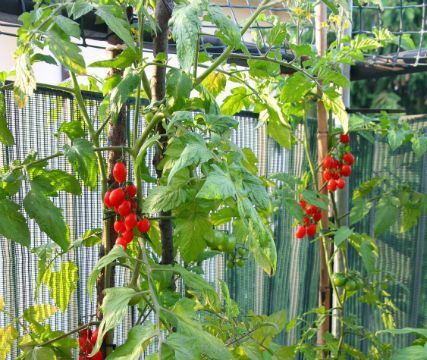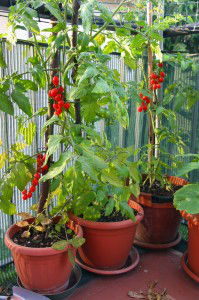
If you don’t have a place to grow a garden, did you know you can still grow your own food? Container gardening is becoming increasingly popular for people with limited space.
Not only is growing your own vegetables a great way to save, but growing food to enjoy yourself, as well as to share with family or friends, is also especially satisfying. If you grow enough, you can even donate to your local food bank or shelter.
The larger the container the better, but almost any container that is non-porous or semi-porous, such as clay, and has drain holes, can be used to grow vegetables. Choosing a lighter-colored container can also help minimize temperature swings. Place them in the sunniest spot available, away from the shade of trees or your home.
Vegetables grown in the ground require soil that is at least 50 percent mineral culture, but for container growing you’ll need a lighter mix that holds moisture well. When filling your containers, use a packaged potting soil that contains plenty of either vermiculite or perlite, or some of both. Feed your container-grown veggies with a mix of compost and organic fertilizer each time you replant, and then follow with an organic, liquid fertilizer after the roots begin to fill the container.
Almost any type of vegetable can be grown in a container, but some are easier than others. Consider these five to start out with:
Tomatoes
Tomatoes are one of the most common vegetables to be grown in containers. Keep in mind that too much heat can damage them, so it’s even more important to plant them in a large, light-colored container. The more root space the plant has, the better the roots will grow—tomatoes can grow to over eight feet tall and two feet across.
Spinach
Spinach and other baby greens are also simple to grow. Plant in the spring when they can tolerate cool temperatures. In cool weather, be sure the plants get plenty of sun, but when warmer weather hits, provide partial shade to keep them from getting too warm.
Radish
Planting radishes can be very rewarding, as they grow quickly and don’t need a lot of depth. Any pot or tray that is at least three inches in depth and has drainage holes will work. They are a cool weather crop, requiring a cool but sunny location for optimal growing. By watering them regularly they’ll be ready to harvest in less than 30 days.
Peppers
Peppers do quite well in containers and they don’t tend to need as much water as many other plants, like tomatoes. They also come in a wide variety of flavors and colors. Peppers like sun, but not too much. If you can place them in an area that gets morning sun or receives filtered light throughout the day, they should grow perfectly. Don’t place them in direct afternoon sun or they can become scorched.
Beets
Beets are also well-suited for container gardening. Use a container that is at least 12 inches deep and place it in a spot where it will receive at least six hours of sunlight. Plant an early spring crop and then again in midsummer for a fall crop.
 Once you get started you may find yourself planting all kinds of vegetables, and even trying new ones you’ve never tasted—what better way to improve your health and have fun?!
Once you get started you may find yourself planting all kinds of vegetables, and even trying new ones you’ve never tasted—what better way to improve your health and have fun?!
-The Alternative Daily

